Firstclass5
On this page, you find all documents, package deals, and flashcards offered by seller FirstClass5.
- 396
- 0
- 32
Community
- Followers
- Following
428 items
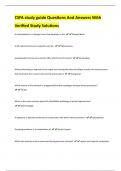
CSFA study guide Questions And Answers With Verified Study Solutions
A cholesteatoma is a benign tumor that develops in the: Mastoid Bone A left subcostal incision is typically used for: Splenectomy postoperative hernias are common after which kind of incision? paramedian When performing an inguinal hernia repair and incising the external oblique muscle, the sensory nerve that innervates the scrotum and must be preserved is? ilioinguinal which section of the stomach is wrapped behind the esophagus during a Nissen procedure? fundus Which is the most comm...
- Package deal
- Exam (elaborations)
- • 3 pages •
A cholesteatoma is a benign tumor that develops in the: Mastoid Bone A left subcostal incision is typically used for: Splenectomy postoperative hernias are common after which kind of incision? paramedian When performing an inguinal hernia repair and incising the external oblique muscle, the sensory nerve that innervates the scrotum and must be preserved is? ilioinguinal which section of the stomach is wrapped behind the esophagus during a Nissen procedure? fundus Which is the most comm...
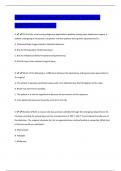
CSFA Test (Gastrointestinal Surgery) Questions With Correct Answers
A Of all of the usual nursing diagnoses applicable to patients having major abdominal surgery, a patient undergoing an ileostomy is at greater risk than patients having other laparotomies for: A. Disturbed Body Image related to intestinal diversion. B. Risk for Perioperative Positioning Injury. C. Risk for Imbalanced Body Temperature (hypothermia). D. Risk for Injury from retained surgical items. D Which of the following is a difference between the laparotomy and laparoscopic approaches t...
- Package deal
- Exam (elaborations)
- • 3 pages •
A Of all of the usual nursing diagnoses applicable to patients having major abdominal surgery, a patient undergoing an ileostomy is at greater risk than patients having other laparotomies for: A. Disturbed Body Image related to intestinal diversion. B. Risk for Perioperative Positioning Injury. C. Risk for Imbalanced Body Temperature (hypothermia). D. Risk for Injury from retained surgical items. D Which of the following is a difference between the laparotomy and laparoscopic approaches t...
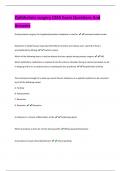
Ophthalmic surgery CSFA Exam Questions And Answers
During cataract surgery, the irrigation/aspiration handpiece is used for removed residual cortex Retraction of eyelid tissues requiring intermittent retraction and release over a period of time is accomplished by utilizing traction sutures Which of the following lasers is used to destroy the lens capsule during cataract surgery YAG Which ophthalmic medications is injected it into the anterior chamber during a cataract procedure to aid in keeping of the iris in position prior to inserting ...
- Package deal
- Exam (elaborations)
- • 2 pages •
During cataract surgery, the irrigation/aspiration handpiece is used for removed residual cortex Retraction of eyelid tissues requiring intermittent retraction and release over a period of time is accomplished by utilizing traction sutures Which of the following lasers is used to destroy the lens capsule during cataract surgery YAG Which ophthalmic medications is injected it into the anterior chamber during a cataract procedure to aid in keeping of the iris in position prior to inserting ...
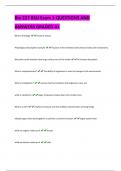
Bio 227 BSU Exam 1 QUESTIONS AND ANSWERS GRADED A+
What is histology study of tissues Physiological description example muscles of the intestinal wall contract slowly and involuntarily. Why does small intestine have large surface area of the inside to increase absorption What is responsiveness? The ability of organisms to react to changes in the environment. What is metabolism? various chemical reactions that organisms carry out what is catobolism larger molecules broken down into smaller ones What is a cell? smallest structural unit that ...
- Package deal
- Exam (elaborations)
- • 9 pages •
What is histology study of tissues Physiological description example muscles of the intestinal wall contract slowly and involuntarily. Why does small intestine have large surface area of the inside to increase absorption What is responsiveness? The ability of organisms to react to changes in the environment. What is metabolism? various chemical reactions that organisms carry out what is catobolism larger molecules broken down into smaller ones What is a cell? smallest structural unit that ...
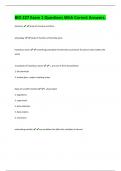
BIO 227 Exam 1 Questions With Correct Answers.
Anatomy study of structure and form physiology study of function of the body parts hazardous waste something potentially harmful that could injure the person who handles the waste 3 examples of hazardous waste 1. any sort of fresh tissue/blood 2. lab chemicals 3. broken glass, scalpel, anything sharp Steps of scientfic method 1. observation 2. hypothesis 3. experiment 4. data collection 5. data analysis 6. conclusion cofounding variable any variables that affect the variables of in...
- Package deal
- Exam (elaborations)
- • 20 pages •
Anatomy study of structure and form physiology study of function of the body parts hazardous waste something potentially harmful that could injure the person who handles the waste 3 examples of hazardous waste 1. any sort of fresh tissue/blood 2. lab chemicals 3. broken glass, scalpel, anything sharp Steps of scientfic method 1. observation 2. hypothesis 3. experiment 4. data collection 5. data analysis 6. conclusion cofounding variable any variables that affect the variables of in...
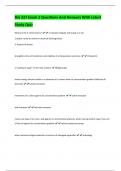
Bio 227 Exam 2 Questions And Answers With Latest Study Quiz
What are the 3 cell functions? ain integrity and shape of a cell n nutrients and form chemical building blocks 3. dispose of wastes strengthens the cell membrane and stabilizes it at temperature extremes cholesterol a "coating of sugar" on the cells surfaces glycocalyx kinetic energy inherent within a a substance as it moves down its concentration gradient (diffusion & Osmosis) passive transport movement of a solute against its concentration gradient active transport bulk transport ve...
- Package deal
- Exam (elaborations)
- • 8 pages •
What are the 3 cell functions? ain integrity and shape of a cell n nutrients and form chemical building blocks 3. dispose of wastes strengthens the cell membrane and stabilizes it at temperature extremes cholesterol a "coating of sugar" on the cells surfaces glycocalyx kinetic energy inherent within a a substance as it moves down its concentration gradient (diffusion & Osmosis) passive transport movement of a solute against its concentration gradient active transport bulk transport ve...
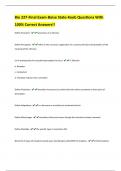
Bio 227-Final Exam-Boise State-Koob Questions With 100% Correct Answers!!
Define Sensation. Awareness of a stimulus. Define Perception. refers to the conscious registration of a sensory stimulus.Interpretation of the meaning of the stimulus List 4 prerequisites for sensation/perception to occur. a. Stimulus b. Receptor c. Conducted d. Translate impulse into a sensation Define Projection. describes the process by which the brain refers sensations to their point of stimulation. Define Adaptation. is a decrease in sensitivity to continued stimuli. Define Afte...
- Package deal
- Exam (elaborations)
- • 32 pages •
Define Sensation. Awareness of a stimulus. Define Perception. refers to the conscious registration of a sensory stimulus.Interpretation of the meaning of the stimulus List 4 prerequisites for sensation/perception to occur. a. Stimulus b. Receptor c. Conducted d. Translate impulse into a sensation Define Projection. describes the process by which the brain refers sensations to their point of stimulation. Define Adaptation. is a decrease in sensitivity to continued stimuli. Define Afte...

Bio 227 Lab Exam 1 questions and answers all are correct 2024 graded A+
total magnification ocular lens x objective lens Proximal Nearer to the trunk of the body Distal Farther from the trunk of the body Anterior front of the body Posterior back of the body Lateral away from the midline Medial toward the midline Caphalad toward the head Caudal toward the tail Dorsal back of body part
- Package deal
- Exam (elaborations)
- • 17 pages •
total magnification ocular lens x objective lens Proximal Nearer to the trunk of the body Distal Farther from the trunk of the body Anterior front of the body Posterior back of the body Lateral away from the midline Medial toward the midline Caphalad toward the head Caudal toward the tail Dorsal back of body part
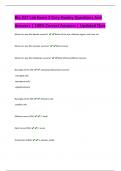
Bio 227 Lab Exam 3 Cory Hanley Questions And Answers | 100% Correct Answers | Updated Quiz
Where can you find bipolar neurons? Retina of the eye, olfactory region, and inner ear Where can you find unipolar neurons? Most sensory Where can you find multipolar neurons? Most CNS and efferent neurons Neuroglia of the CNS -astrocytes (blood-brain barrier) -microglial cells -ependymal cells -oligodendrocyte Neuroglia of the PNS -Schwann cells -satellite cells Olfactory nerve (CNI) 1- Smell Optic nerve (CNII) 2- visual
- Package deal
- Exam (elaborations)
- • 15 pages •
Where can you find bipolar neurons? Retina of the eye, olfactory region, and inner ear Where can you find unipolar neurons? Most sensory Where can you find multipolar neurons? Most CNS and efferent neurons Neuroglia of the CNS -astrocytes (blood-brain barrier) -microglial cells -ependymal cells -oligodendrocyte Neuroglia of the PNS -Schwann cells -satellite cells Olfactory nerve (CNI) 1- Smell Optic nerve (CNII) 2- visual
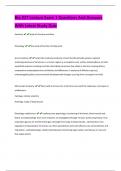
Bio 227 Lecture Exam 1 Questions And Answers With Latest Study Quiz
Anatomy study of structure and form Physiology the study of function of body parts Gross Anatomy systematic anatomy (anatomy of each functional body system), regional anatomy(examines all structures in a certain region as a complete unit), surface anatomy(focus on both superficial anatomic markings and the interal body structures that relate to the skin covering them), comparative anatomy(examines similarities and differences in anatomy of different species), embryology(discipline conc...
- Package deal
- Exam (elaborations)
- • 26 pages •
Anatomy study of structure and form Physiology the study of function of body parts Gross Anatomy systematic anatomy (anatomy of each functional body system), regional anatomy(examines all structures in a certain region as a complete unit), surface anatomy(focus on both superficial anatomic markings and the interal body structures that relate to the skin covering them), comparative anatomy(examines similarities and differences in anatomy of different species), embryology(discipline conc...
